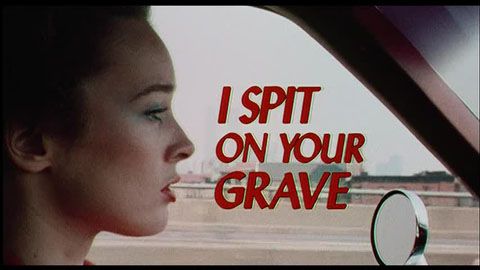Rented from Netflix July 15th, 2009
Roger Ebert said it was one of the worst films he'd ever seen. And it's probably up there. One of the first thoughts that I had when watching the movie was that "Boy, this was a lot better when it was Last House on the Left and Deliverance."
Jenny Hill, a beautiful young writer from New York City decides to spend her summer in a secluded cabin to write her first novel. Literally every man she personally encounters in this tiny town decides that she's a sexy but snooty big city girl, and so what do good rednecks do with city people? Have you seen Deliverance?
Queue the banjo music. This movie falls into an exploitation subgenre called the "rape and revenge movie," wherein a pretty young girl is physically assaulted by one or several men, left for dead, and either seeks revenge on the attackers directly, or is killed, leaving her loved ones to seek revenge on her behalf.
On the one hand, this subgenre could be seen as an updated throwback to classic cinema, wherein the villain's dastardly behavior is ultimately repaid in their gruesome and completely justified murders. However, there is often a lot of controversy involved given their graphic, brutal, and unsettling sex scenes, followed closely thereafter by equally brutal and extreme revenge scenes. It can basically be seen as being so extremely and ridiculously "feminist," that it goes all the way back around to being misogynistic. These films are invariably directed by men, as well.
In some ways, I agree with Roger Ebert. The initial rape scenes are incredibly graphic. Not only that, but there's a sense that it will never stop. Mostly, it seems this way because the act itself is perpetrated by four men, and takes place in three locations, ending within Jenny's very own cabin. Not only that, but the nefarious hillbillies tear up her manuscript, violating not only her physical body and sense of safety, but her creative output and work, leaving her with nothing left. The scene that takes place in her cabin is doubly visceral in the several shots where she is sprawled on the floor, a hideously '70s but appropriate black-and-red monstrosity, which makes her look as though she's still sprawled in blood. The final man, Matthew, seemingly a sweet simpleton, is charged with the task of stabbing the girl to death. Being the George-from-Of-Mice-and-Men partial defective that he is, he doesn't really kill her, which allows her to recuperate for two weeks in peace, eventually healing (physically), piecing her manuscript back together (in some none-too-subtle parallelism), and eventually resuming her work. This is the point where the realism diverges in these movies: The girl decides that she' go all Charles Bronson on their asses and wreak her savage revenge.
In these types of slasher films, the female lead is always difficult for male audiences to identify with. That's why she's often given a distinctively phallic weapon (knife, boat oar, machete, and to a lesser extent, a gun), which she is able to turn on her male attacker. The main reason that most critics are harsh of the message of this movie is that Jenny exploits the hillbilly's moronic sexuality by luring them to their doom with her own sexual advances. The question that you have to ask is: Would anyone actually be so stupid as to think that a woman that they assaulted (without masks, or fake names, or any other ways of hiding their identities) would actually be willing to pursue them? Of course, they pay dearly for this shortsightedness with their lives (and in one leg-crossingly graphic scene, their actual manhood). I would have loved to see waifish Jenny Hill toss aside her typewriter and big-ol' 1970s glasses and go Jason Voorhees on their asses, stalking them like a hideous golem through the very woods that they inhabit, in an endless and bloody pursuit until they are all but tiny hick-chunks all over the forest floor.
Not much can really be said of Meir Zarchi's "style" of "directing" this "movie." He seems to be very much of the school of "point the camera at things while stuff happens." There isn't a lot of camera movement (aside from panning and tilting, which doesn't really count as "movement"), which might mean something; on the other hand, it might mean that he didn't have a steadi-cam or wheels for a tracking shot. There also isn't any soundtrack present in the film, and the few pieces of music that we do hear are presented diagetically (from within the sphere of the scene itself). He doesn't do anything groundbreaking directorially, and as far as the written script goes, he owes much to The Last House on the Left and Deliverance, both released in 1972.
Oh, hey, you probably wanted to get some sort of review here, some idea of whether or not the movie is worth watching, and not some vague, half-baked mini-essay about it. I give it three and a half stars out of five. There are better films to watch in this genre, but this one stands out primarily because of the controversy it garnered due to its graphic nature (as well as the fact that the uncut version was initially distributed with an "R" rating, unbeknownst to the director) and robustly negative and disgusted reviews.
Bottom line is, if you want to see a hillbilly gas station attendant brutally castrated in a bathtub, hey, you're probably sick in the head, but this movie totally has that.


No comments:
Post a Comment